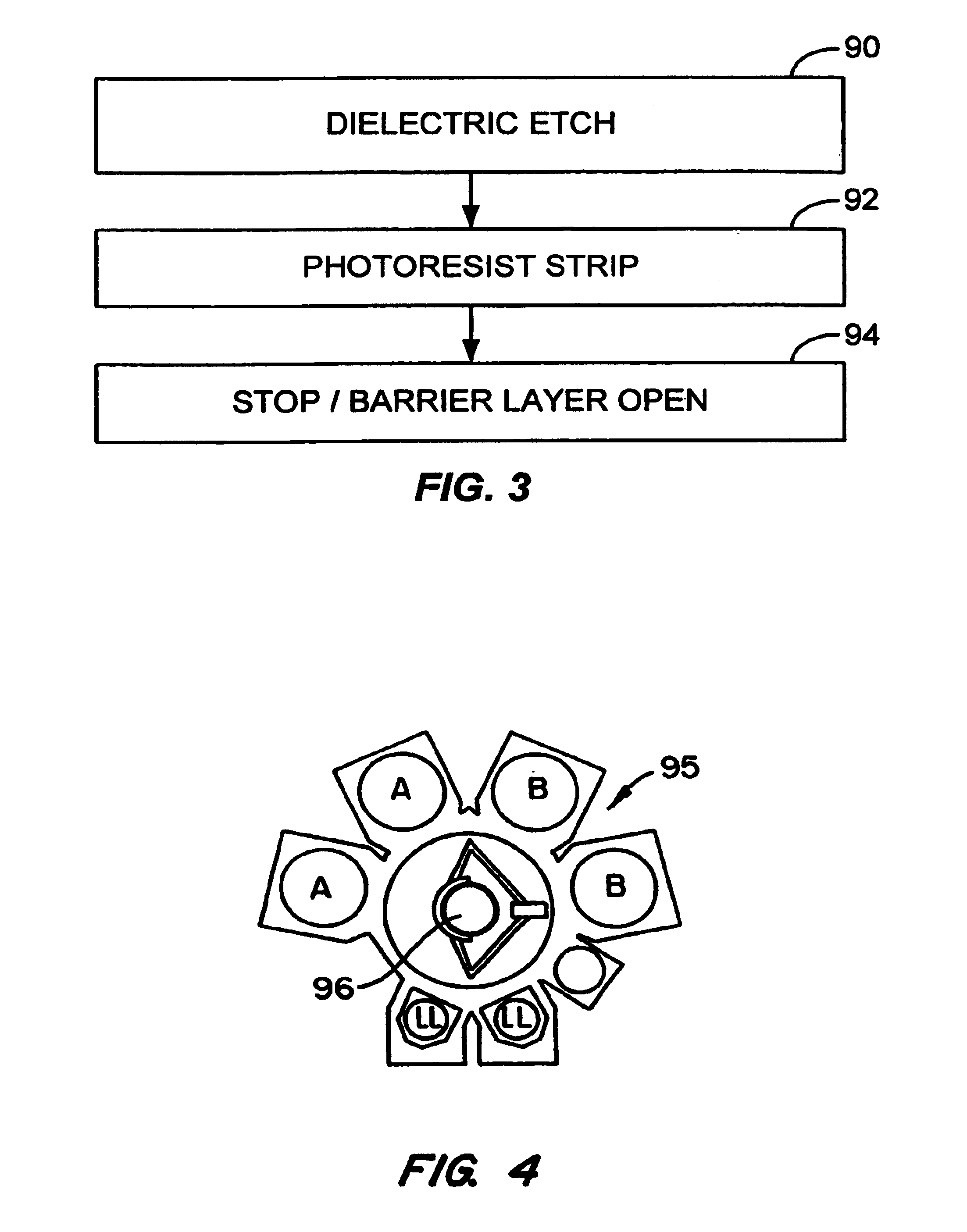System level in-situ integrated dielectric etch process particularly useful for copper dual damascene
a dielectric etching and integrated technology, applied in the field ofplasma etching processes, can solve the problems of significant cost of ownership benefits, undesirable isotropic etching effect on the dielectric layer, and overetching of the dielectric layer including the loss of critical dimensions, so as to reduce the cost of ownership and improve the etching
- Summary
- Abstract
- Description
- Claims
- Application Information
AI Technical Summary
Benefits of technology
Problems solved by technology
Method used
Image
Examples
invention example 1
[0090]The first example is particularly useful for a single damascene metal 1 trench etch process. In some applications it is common to form such a single damascene structure for a metal 1 layer before using a dual damascene approach to additional, overlying metal layers. FIG. 6A shows an example of a substrate 200 having a three layer dielectric stack 202 to be etched in step 90. Dielectric stack 205 includes an organic, bottom antireflective coating (BARC) 204, formed over an inorganic, dielectric antireflective coating (DARC) 206, which is formed over a Black Diamond™ layer 208. A deep UV photoresist material 210 is formed over the dielectric stack and a BloK™ layer 212 separates the dielectric stack from the underlying substrate.
[0091]Table 1 set forth below shows the basic steps used to etch the dielectric material, strip the photoresist and open the barrier layer (steps 90, 92 and 94, respectively). As shown in Table 1, step 90 includes two separate steps: a first main etch st...
invention example 2
[0094]The second example is particularly useful for a via etch process such as one used to etch via 222 in substrate 220 shown in FIG. 6B. Substrate 220 includes a BARC layer 224 formed over a DARC layer 226, which is formed over a Black Diamond™228. Layer 228 serves as both the trench and via dielectric layers. A deep UV photoresist material 230 is formed over the dielectric stack and a BloK™ layer 232 separates the dielectric stack from the underlying substrate. A middle stop layer is not included between the trench and dielectric layers as the process relies on the iRM to endpoint the trench etch in a later step.
[0095]This example etches a via in the substrate 220 using a three-step etch process as dielectric etch step 90 that is highly selective to the photoresist and bottom BloK™ layer. In the first step, the BARC layer is etched using a CF4 plasma; the main etch step uses a CHF3 and N2 plasma and the final, over etch step uses a C4F6, O2 and CO plasma. Further details of diele...
invention example 3
[0098]The third example is particularly useful for a dual damascene trench etch process such as one used to etch substrate 240 shown in FIG. 6C. Substrate 240 includes a DARC layer 242 formed over a Black Diamond™ layer 244. The Black Diamond™ layer 244 serves as both the trench and via dielectric layers and does not include a middle stop layer. A deep UV photoresist material 246 is formed over the dielectric stack and a BloK™ layer 248 separates the dielectric stack from the underlying substrate.
[0099]In this example a trench may be etched in substrate 240 using a two step etch process, such as that shown in Table 3 below, as dielectric etch step 90. In the first step, the DARC layer is etched using a CF4 plasma while the main trench etch step uses a CF4, N2 and Ar plasma. The subsequent photoresist strip and stop layer open steps 92 and 94 may use the same parameters as these shown in Table 1 above.
[0100]
TABLE 3PROCESSES CONDITIONS FOR INVENTION EXAMPLE 3ParameterDielectric EtchGa...
PUM
| Property | Measurement | Unit |
|---|---|---|
| Temperature | aaaaa | aaaaa |
| Power | aaaaa | aaaaa |
| Power | aaaaa | aaaaa |
Abstract
Description
Claims
Application Information
 Login to View More
Login to View More - R&D
- Intellectual Property
- Life Sciences
- Materials
- Tech Scout
- Unparalleled Data Quality
- Higher Quality Content
- 60% Fewer Hallucinations
Browse by: Latest US Patents, China's latest patents, Technical Efficacy Thesaurus, Application Domain, Technology Topic, Popular Technical Reports.
© 2025 PatSnap. All rights reserved.Legal|Privacy policy|Modern Slavery Act Transparency Statement|Sitemap|About US| Contact US: help@patsnap.com



